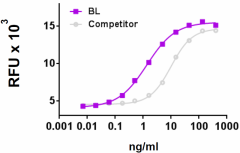- Regulatory Status
- RUO
- Other Names
- Interleukin-3, Burst promoting activity, Eosinophil colony stimulating factor (Eo-CSF), Hematopoietic cell growth factor (HCGF), Mast (MGF/MCGF), Multi-colony stimulating (Multi-CSF), P cell stimulating activity (PCSA), Thy1 inducing factor

-

Recombinant rat IL-3 induces the proliferation of M-NFS-60 mouse myelogenous leukemia lymphoblast cells in a dose dependent manner. BioLegend’s protein was compared side-by-side to a competitor’s equivalent product.
| Cat # | Size | Price | Quantity Check Availability | ||
|---|---|---|---|---|---|
| 750202 | 10 µg | $223.00 | |||
| 750204 | 25 µg | $440.00 | |||
Select size of product is eligible for a 40% discount! Promotion valid until December 31, 2024. Exclusions apply. To view full promotion terms and conditions or to contact your local BioLegend representative to receive a quote, visit our webpage.
Interleukin 3, also known as IL-3, was initially described in the supernatant of cultures of viral-infected murine spleen cells. Mature rat IL-3 surprisingly shows low homology (54%) with its murine counterpart. IL-3 is the most potent growth factor for basophils followed by the granulocyte-macrophage colony-stimulating factor and IL-5. These cytokines also act on mature basophils through specific receptors, thereby mediating adhesion, migration, and release of the cells. IL-3 is highly expressed by mast cells. Rapid autocrine production of large amounts of the cytokine is responsible for mast cell IgE-induced survival in the absence of antigen. In addition, IL-3 and its receptors are expressed in neuronal progenitors and neurons. IL-3 has been associated to human brain volume variation by regulating proliferation and survival of neural progenitors. It has also been implicated in the pathogenesis of several chronic inflammatory diseases, which include asthma, atherosclerosis, and neurodegenerative disorders such as multiple sclerosis.
Product Details
- Source
- Rat IL-3, amino acids Met-(Ile27-Cys169) (Accession# NM_031513.1), was expressed in E.coli.
- Molecular Mass
- The 144 amino acid recombinant protein has a predicted molecular mass of approximately 16.3 kD. The protein migrates at approximately 18 kD in DTT-reducing conditions and 16 kD in non-reducing conditions by SDS-PAGE. The predicted N-terminal amino acid is Met.
- Purity
- >95%, as determined by Coomassie stained SDS-PAGE.
- Formulation
- 0.22 µm filtered protein solution is in PBS pH 7.2.
- Endotoxin Level
- Less than 0.01 ng per µg cytokine as determined by the LAL method.
- Concentration
- 10 and 25 µg sizes are bottled at 200 µg/mL. 100 µg size and larger sizes are lot-specific and bottled at the concentration indicated on the vial. To obtain lot-specific concentration and expiration, please enter the lot number in our Certificate of Analysis online tool.
- Storage & Handling
- Unopened vial can be stored between 2°C and 8°C for up to 2 weeks, at -20°C for up to six months, or at -70°C or colder until the expiration date. For maximum results, quick spin vial prior to opening. The protein can be aliquoted and stored at -20°C or colder. Stock solutions can also be prepared at 50 - 100 µg/mL in appropriate sterile buffer, carrier protein such as 0.2 - 1% BSA or HSA can be added when preparing the stock solution. Aliquots can be stored between 2°C and 8°C for up to one week and stored at -20°C or colder for up to 3 months. Avoid repeated freeze/thaw cycles.
- Activity
- ED50 = 1 - 5 ng/ml, corresponding to a specific activity of 0.2 — 1.0 x 106 units/mg, as determined by the dose dependent stimulation of a M-NFS-60 cell proliferation assay.
- Application
-
Bioassay
- Application Notes
-
BioLegend carrier-free recombinant proteins provided in liquid format are shipped on blue-ice. Our comparison testing data indicates that when handled and stored as recommended, the liquid format has equal or better stability and shelf-life compared to commercially available lyophilized proteins after reconstitution. Our liquid proteins are verified in-house to maintain activity after shipping on blue ice and are backed by our 100% satisfaction guarantee. If you have any concerns, contact us at tech@biolegend.com.
Antigen Details
- Structure
- Cytokine.
- Distribution
-
Activated T cells, Th1, Th2, mast cells, eosinophils, keratinocytes, natural killer cells (NK), and endothelial cells.
- Function
- IL-3 promotes both self-renewal and differentiation of early multipotential progenitors and is involved in inducible hematopoiesis in response to infections. IL-3 stimulates colony formation of megakaryocytes, neutrophils, and macrophages from bone marrow cultures.
- Interaction
- Erythroid cells, megakaryocytes, neutrophils, eosinophils, basophils, mast cells, and monocytic lineages.
- Ligand/Receptor
- Heterodimer IL-3Rα (CD123) and two alternate β-subunits, AIC2A binds IL-3 and is specific to IL-3Rα, AIC2B (CDw131) shared in common with IL-5R, GM-CSFR.
- Cell Type
- Hematopoietic stem and progenitors
- Biology Area
- Cell Biology, Stem Cells
- Molecular Family
- Cytokines/Chemokines
- Antigen References
-
1. Kohno M, et al. 2005. Blood 105:2059-2065.
2. Valent P and Dahinden CA. 2010. Curr. Opin. Hematol. 17:60-66.
3. Kleemann R, et al. 2008. Cardiovascular Research 79:360-376.
4. Murphy JM, Young IG. 2006. Vitam Horm. 74:1-30.
5. Luo XJ, et al. 2012. PLoS One 7:e50375. - Gene ID
- 24495 View all products for this Gene ID
- UniProt
- View information about IL-3 on UniProt.org
